Last updated 10 June 2020
Hoi An Highlights
The town of Hoi An was one of my Vietnam highlights. Because this year (2017) is the United Nation International Year of Sustainable Tourism for Development, I wanted to write about how you can travel “responsibly” in Hoi An.
Situated on Vietnam’s central coast, Hoi An once a busy port is now a hot spot for a different commodity – tourists. The UNESCO listed old town with just 120,000 residents attracts over 1.5 million visitors every year, many of whom are keen to check out the old town’s intriguing mish mash of architectural styles incorporating French, Chinese and Japanese influences. Tourist businesses are flourishing in Hoi An including hundreds of tailors where handmade high couture fashion can be purchased at a fraction of the cost at any European fashion house.
Thanks to a classic Top Gear episode – the Vietnam special released in December 2008, parts of Vietnam were exposed in a “unique” fashion. The Top Gear lads stopped off in Hoi An and visited a tailor’s shop to organise the making of three garish bespoke suits, which they wore in the remainder of the episodes. This semi-random act catapulted the town into a new tourist stratosphere as the go to place for personally fitted handmade garments. As Jeremy Clarkson quipped, “Hoi An is Vietnam’s version of Saville Row.”
Should you decide to visit one of Hoi An’s tailors to have something made, unless you have a TV crew and incredible pull to turn your outfit round from initial fitting to finished in 24 hours, you’ll need a couple of days. This gives adequate time to select a recommended tailor, have a minimum two fittings and leave with any number of made to fit dresses, blouses, business shirts or suits. While waiting for the creation of your personally fitted tailored pieces, why not consider a couple of activities in Hoi An that are making a difference to locals in the community. During my three day stay, choosing experiences and making purchases from a couple of not for profit organisations and charities, I found out how to travel responsibly in Hoi An.
Not for Profit organisations
STREETS International
STREETS International’s mission is to provide Vietnamese children from impoverished backgrounds the opportunity to gain experience in hospitality. It was established in 2007 by Americans Neal Bermas and his partner, Sondra Stewart. Bermas first visited Vietnam in 1997. As a regular business traveller, Bermas was concerned about the lack of opportunities for many Vietnamese street kids unable to escape the poverty cycle. Burmas wanted to do something to help the vulnerable, disadvantaged kids who often went uneducated due to there either not being enough schools in the area, or because the children were required to stay home and help the family earn money.
Children apply to STREETS and those selected attend an 18-month training program, receiving relevant skills at a culinary and hospitality school. The STREETS graduates leave with the credentials and confidence to forge careers in Vietnam’s growing tourism and hospitality.
Checking on the progress of the graduates, at the time of writing this post, STREETS confirmed 100% of the 250 graduates from the STREETS program found work at a 4 or 5-star international hotel or resort within 60 days of graduation. After several years of work experience, a number of the graduates have found employment in supervisory positions in Singapore, Dubai, Maldives and the UAE, demonstrating the success of the program.
Thanks to a partnership developed between *G Adventures, the Planaterra Foundation and STREETS, anyone on a G Adventures tour, when visiting Hoi An participate in a fun noodle making cooking class called Oodles of Noodles. As I was on a seven day G Adventures tour, before I left Australia for Vietnam, I’d been informed about how amazing the STREETS International program is (thanks Caroline!) So I organised to meet and interview Sondra Stewart, one of the founders of Streets International to help me better understand their focus and mission.
Originally a US-based business strategy expert and independent consultant, Sondra explained they chose Hoi An because the town draws tourists and has the restaurant which supports the program.
“It is not our intention to be an educational facility, we’re here to train our kids so they can get jobs,” says Sondra. “The reputation of the STREETS program, certainly in this region is such that anyone who obtains a certification with our training program, is welcomed with open arms. With Oodles of Noodles you experience a classroom, can ask questions and talk with the students. These kids are lecturing to groups of foreigners. Not only are they speaking to adults who are older and taller than they are, but they’re also speaking in their non-native language,” she says with a knowing smile. “I mean it’s amazing!”
Time for class
When our G Adventures tour group of 15 arrived at the STREETS International school for the noodle class, we’re ushered into a room lined with stainless steel benches and cooking utensils. Two trainees introduce themselves. These kids openly talk about this being an opportunity to leave their impoverished backgrounds and make something of themselves. Their enthusiasm shows as they confidently practise speaking English.
“I thought it was wonderful how the trainees actually conducted the class,” says Mark, a retired toxicologist from San Jose, America. “In their narrative, they taught us to prepare the food. It was endearing to see the confidence in these kids based on their age. Any program that prepares you like that can only enhance their confidence in the world.”
We all enjoyed the interaction with the students and our attempts at making a simple plate of noodles (harder than you’d think!) After the lesson we sat down to a delicious lunch including the noodles we helped prepare.
Streets run a café at 17 Le Loi Street in Hoi An’s the central district, where trainees practise what they’re learning on the paying public. Sampling their delicious white rose dumplings while enjoying a cocktail or two feels even better, knowing doing so helps support the local street kids to have a brighter future.
“If you want to do something to have that connection, rather than give someone money and wonder what will that do, choose Oodles of Noodles,” said Sondra.
I couldn’t agree more.
The Lifestart Foundation
The Lifestart Foundation in Hoi An’s Old Town is a not-for-profit charity established by Australian Karen Leonard, to help disadvantaged Vietnamese people and their families become self-sufficient. Their retail outlet and workshop in the quiet Nguyen Thai Hoc back street is a five minute walk from the Japanese covered bridge. The store sells beautiful hand-made arts and crafts and is also a workshop where you can watch as the women make their handicraft.
Lifestart is open about how the money is distributed. Once the shop fees are taken out, all profits from sales of the individual’s handicrafts are given to the women who’ve made them. I may have paid 20,000 dong more for a similar lantern bought in the markets at 100,000 dong ($6Aud), but knowing my money was going directly to the maker made me feel I was spending responsibly. (And why would I quibble over $1Aud?) Watching the women at their workstations, making craft in clean, safe surroundings and knowing any purchases goes back to these women provides a sense of transparency.
Not only is it a workshop for the Vietnamese, you can enrol in your own art class at Lifestart. (Book online or in the store.) Another traveler on my tour, Andy from Bromscrove in the UK, joined me in two of the art classes, held on the first floor of the workshop. The first was a Japanese lantern making class conducted by the delightful Dung (pronounced Yo-ung) who lived in Essendon, Melbourne for a few years. With excellent conversational English, Dung was happy to chat about life in Vietnam as she instructed us through the steps on how to make a miniature lantern.
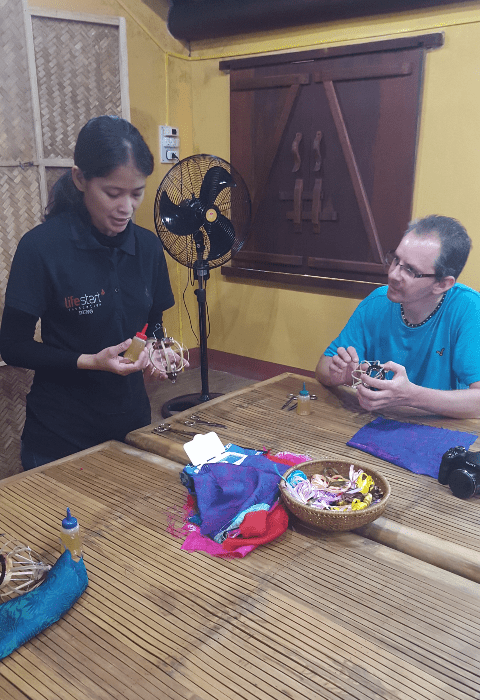
Lifestart employee Dung shows Andy how to make a miniature lantern
“Many people in our centres have disabilities from polio and we also have people who’ve had accidents and can’t work,” says Dung. “One lady is a paraplegic who lost both of her legs in an accident and another lady aged in her 60’s also lost both her legs during the American war when a bomb dropped on her house and she was the last person to leave the house.” (I found it interesting when Dung refererred to the Vietnam war as the “American” war.)
Dung says the majority of workers at Lifestart are women, but there are a few men. The workers have access to a rehabilitation centre across town, where they can exercise to improve their health. “Physios from around the world come to volunteer and help out at the rehab centre for a few months,” said Dung.
In the second class Andy and I attempt watercolour painting. Our teacher a renowned Vietnamese local artist and Lifestart Foundation recipient, Sinh Trong showed much patience with my attempts at replicating his drawings. Sinh showed us how to hold the paint brush, then dip it in an oil based charcoal (the special ingredient for the ink: smoke!)
Charities:
Blue Dragon Restaurant
The Blue Dragon charity was established by Australian school teacher Michael Bresowski. Their mission is to help children escape the poverty cycle, trafficking and drug addiction by offering them education and improved living conditions. Although Hanoi based, a restaurant in Hoi An, The Blue Dragon restaurant run by a colourful character called Mr Nam supports the Blue Dragon charity. I contacted Michael Bresowski to clarify how things work in Hoi An. “The Blue Dragon restaurant is a privately owned and operated business supporting our charity by giving a set donation each month to us,” said Michael. Knowing the proprietor supports the Blue Dragon charity – a sign on shop front proudly announces this – gives the responsible traveller a dining option to enjoy Vietnamese food with a cold drink.
Handmade products supporting disadvantaged Vietnamese
If you’re looking to fill your suitcase or backpack with a few gifts to take home (provided you have space unlike me who was so taken with the Japanese lanterns I bought three large ones.) Check out these places in Hoi An.
Tohe is a Vietnamese social enterprise supporting children from disadvantaged backgrounds. The Tohe team reach out to children in orphanages, centres for children with disabilities, schools in remote areas and kids in hospitals. They encourage the children to participate in art activities. Some of the art produced by the children is redesigned and printed on products such as clothes, backpacks, ipad cases, and home décor, available at their Hoi An store (as well as online.) Various shops around Vietnam stock their handmade products, but you will find their Hoi An showroom at 193 Cua Dai. A portion of the profits are used to fund the creative classes and scholarship programs for talented children.
Reaching out Arts and Crafts store sells handmade products made by disabled and disadvantaged Vietnamese. And Mekong Plus is a NGO located at 136 Tran Phu, Hoi An selling beautiful handmade quilts, bedding, tableware and children’s clothing. These crafts are made by impoverished women from remote and rural parts of Vietnam and Cambodia.
Other activities around Hoi An
There are a number adventure activities choices in and around Hoi An . My half day cycling tour was fun apart from the inclement weather. Others in the tour group chose abseiling.
Another “more relaxing” activity in our group were spa visits for massage, facials, pedicures or manicures.
The old town has a number of bars to take a load off and watch Hoi An life go by if that’s your thing. Here’s my pick of the bars in Hoi An to check out either after dark or during the day.
Once you have your garment
When the time comes to collect your handmade items from your tailor or selection of tailors, your next Vietnam destination awaits.
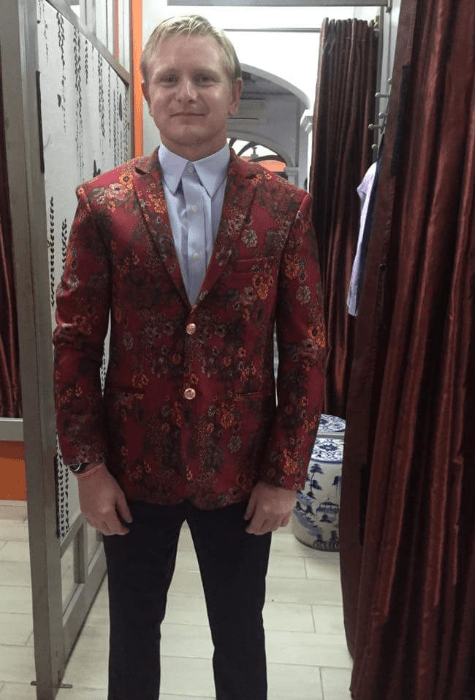
Dave from our tour and his spectacular jacket made at the same tailor the Top Gear lads chose (photo courtesy: Dave P)
I know it may not make a difference to many travellers where they spend their tourist dollar, but if you’re like me and have taken the time to discover more about the country you’re visiting, you will have figured Vietnam and its people have suffered through a violent history; its government does not make provision for a social welfare system and there are a large percentage of the population live on a lower socio-economic scale relying heavily on the tourist dollar to survive.
It can’t hurt to consider what you can do to travel “responsibly.”
As Sondra Stewart from Streets International says, “Not every tourist who comes to Vietnam wants to bother about traveling responsibly and do oodles of research about where to go and what to do. But what if someone does that research for them and then shares the information? It is then up to a traveler to decide if they want to go down that path or not. If I were to give advice to a traveler keen to be responsible, I’d suggest they need to look at the greater impact of what we are doing.”
Why I chose G Adventures
One of the reasons I selected *G Adventures tours to travel through Vietnam was because of their efforts to choose activities that are fundamentally “responsible.” Throughout the tour, our guide Meou would remind us of how to do these small things.
Hopefully, your visit to Hoi An will be filled with positive memories and if this article prompts you to travel responsibly while you’re there – I am grateful. And please let me know in the comments below, some of your favourite memories of Hoi An.
*My trip was not sponsored or subsidised by G Adventures – it was paid for by myself. I have no affiliate links in this article. These comments are my own.
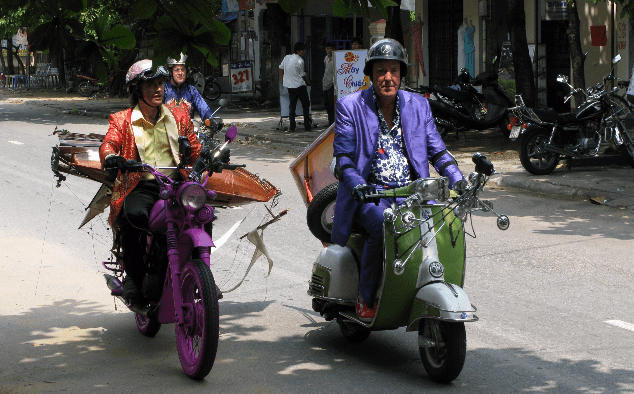
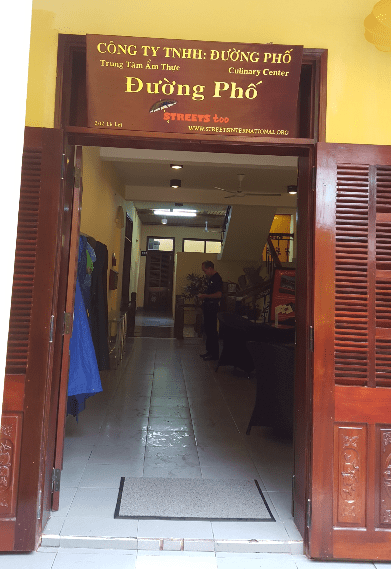
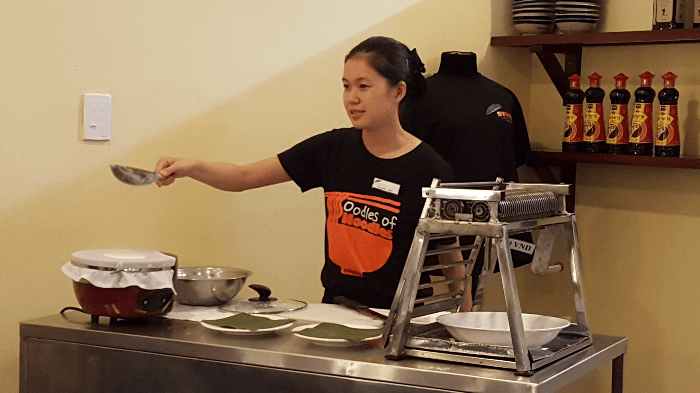
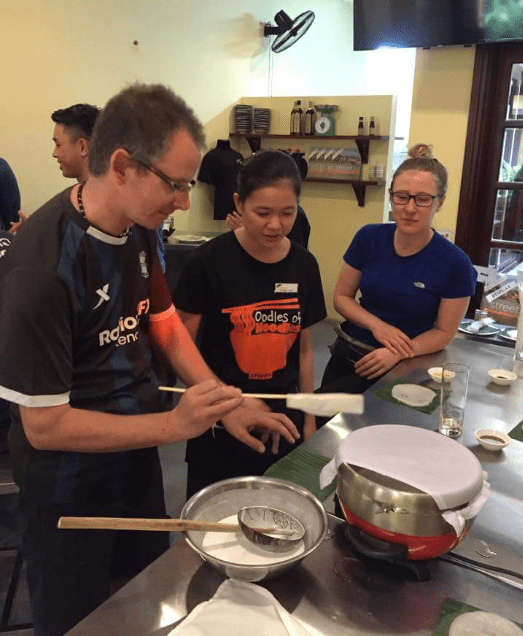
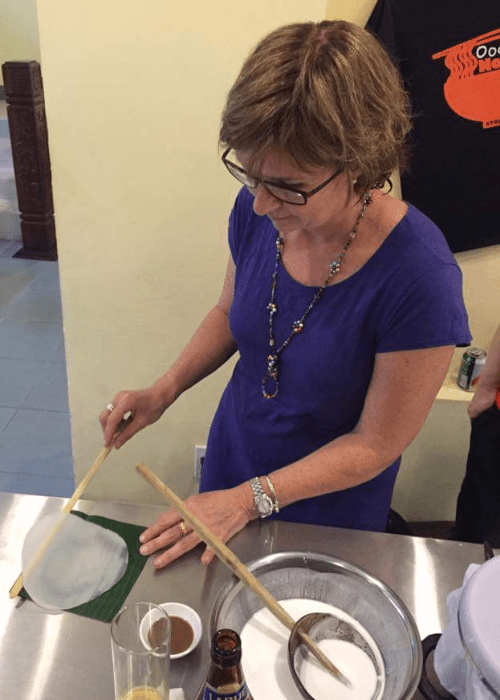
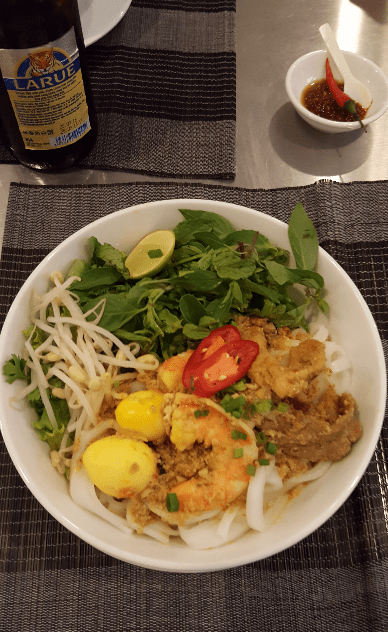
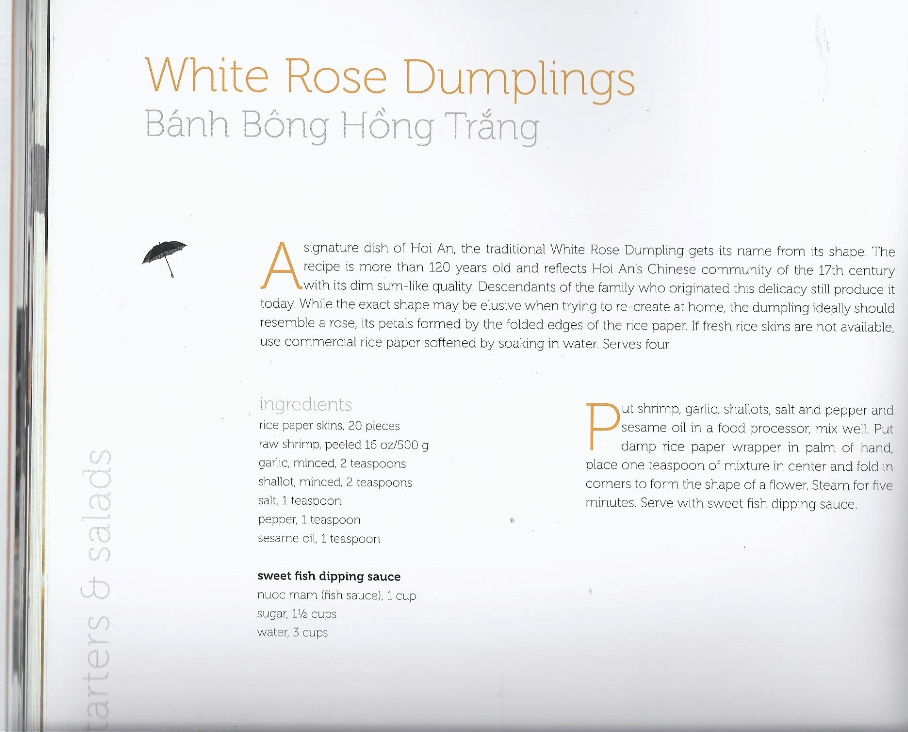
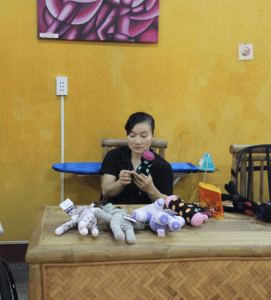
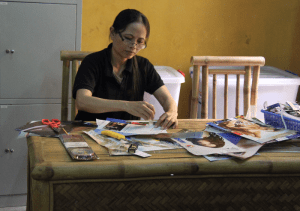
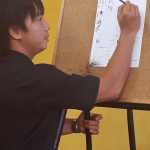
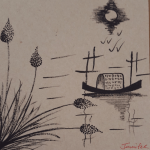
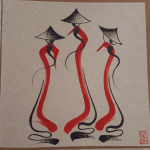
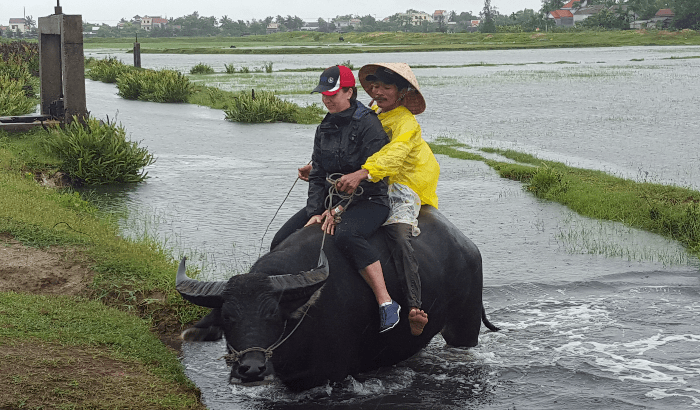
Such an informative and helpful post. Thanks for sharing and looking forward reading more your other blogs.
Thank you Alice, I’m glad you enjoyed my story and took the time to reply.
Jennifer